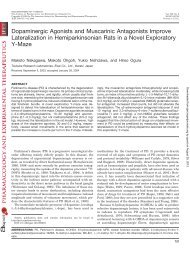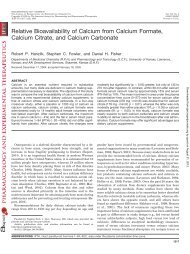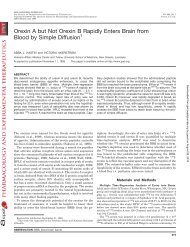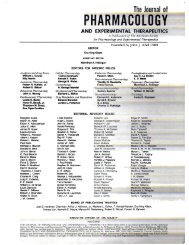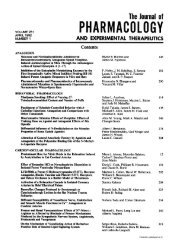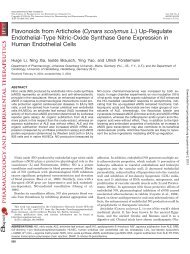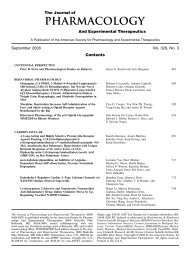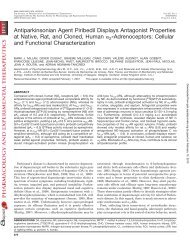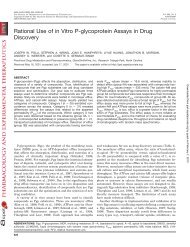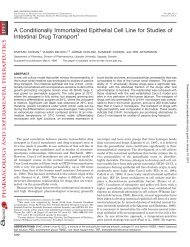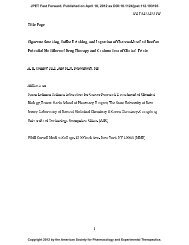A-770041, a Novel and Selective Small-Molecule Inhibitor of Lck ...
A-770041, a Novel and Selective Small-Molecule Inhibitor of Lck ...
A-770041, a Novel and Selective Small-Molecule Inhibitor of Lck ...
Create successful ePaper yourself
Turn your PDF publications into a flip-book with our unique Google optimized e-Paper software.
<strong>Lck</strong> / mice show thymic atrophy from a reduction in<br />
double-positive thymocytes <strong>and</strong> pr<strong>of</strong>ound lymphopenia with<br />
a 100-fold reduction in mature CD4 cells <strong>and</strong> a 3-fold reduction<br />
in mature CD8 cells (Molina et al., 1992). Although the<br />
lack <strong>of</strong> <strong>Lck</strong> expression through development <strong>of</strong> the knockout<br />
mouse certainly affects thymopoiesis, lack <strong>of</strong> <strong>Lck</strong> expression<br />
in peripheral mature T cells does not alter survival (Legname<br />
et al., 2000; Seddon et al., 2000). In a doxycycline-inducible<br />
<strong>Lck</strong>-transgenic mouse on an <strong>Lck</strong>/ background, when<br />
doxycycline is fed through development, there is a relatively<br />
normal repertoire <strong>of</strong> mature T cells. Cessation <strong>of</strong> doxycycline<br />
treatment <strong>and</strong> loss <strong>of</strong> <strong>Lck</strong> expression results in decreased<br />
thymopoiesis but no effects on the numbers <strong>of</strong> circulating<br />
mature T cells for several months. Circulating T cells from<br />
the <strong>Lck</strong> / mice have a significantly decreased proliferative<br />
response, calcium mobilization, <strong>and</strong> IL-2 production (Straus<br />
<strong>and</strong> Weiss, 1992; Trobridge <strong>and</strong> Levin, 2001). These data<br />
suggest that the inhibition <strong>of</strong> <strong>Lck</strong> with a small molecule<br />
should have no effect on the number <strong>of</strong> mature circulating T<br />
cells or survival <strong>of</strong> these cells but should be expected to block<br />
activation <strong>and</strong> proliferation.<br />
<strong>Inhibitor</strong>s <strong>of</strong> <strong>Lck</strong> may also be efficacious in other inflammatory<br />
diseases, including rheumatoid arthritis, multiple<br />
sclerosis, inflammatory bowel diseases, type 1 diabetes, systemic<br />
lupus erythematosus, <strong>and</strong> psoriasis (Kamens et al.,<br />
2001). In conclusion, we have discovered A-<strong>770041</strong>, a selective<br />
inhibitor <strong>of</strong> <strong>Lck</strong> that is orally active, inhibits T cell<br />
activation <strong>and</strong> proliferation <strong>and</strong> prevents allograft rejection<br />
in transplanted hearts similar to Cyclosporin A for up to 65<br />
days. These data show that selective inhibitors <strong>of</strong> <strong>Lck</strong> have<br />
the potential to be efficacious in preventing acute rejection.<br />
These inhibitors would be expected to avoid the renal effects<br />
<strong>of</strong> long-term therapy with Cyclosporin A.<br />
Acknowledgments<br />
We thank Elizabeth O’Connor <strong>and</strong> Jamie Erickson for expert<br />
processing <strong>of</strong> the tissue sections from this study <strong>and</strong> ABC Bioresources<br />
for help with dosing <strong>and</strong> pr<strong>of</strong>essional care <strong>of</strong> animals on this<br />
study.<br />
References<br />
Barber EK, Dasgupta JD, Schlossman SF, Trevillyan JM, <strong>and</strong> Rudd CE (1989) The<br />
CD4 <strong>and</strong> CD8 antigens are coupled to a protein-tyrosine kinase (p56lck) that<br />
phosphorylates the CD3 complex. Proc Natl Acad Sci USA 86:3277–3281.<br />
Borhani DW, Calderwood DJ, Friedman MM, Hirst GC, Li B, Leung AK, McRae B,<br />
Ratn<strong>of</strong>sky S, Ritter K, <strong>and</strong> Waegell W (2004) A-420983: a potent, orally active<br />
inhibitor <strong>of</strong> lck with efficacy in a model <strong>of</strong> transplant rejection. Bioorg Med Chem<br />
Lett 14:2613–2616.<br />
A-<strong>770041</strong> Prevents Acute Rejection 41<br />
Duplay P, Thome M, Herve F, <strong>and</strong> Acuto O (1994) p56lck interacts via its src<br />
homology 2 domain with the ZAP-70 kinase. J Exp Med 179:1163–1172.<br />
Kamens JS, Ratn<strong>of</strong>sky SE, <strong>and</strong> Hirst GC (2001) <strong>Lck</strong> inhibitors as a therapeutic<br />
approach to autoimmune disease <strong>and</strong> transplant rejection. Curr Opin Investig<br />
Drugs 2:1213–1219.<br />
Korecky B <strong>and</strong> Masika M (1990) Use <strong>of</strong> a heterotopic cardiac isotransplant for<br />
pharmacological <strong>and</strong> toxicological studies. Toxicol Pathol 18:541–546.<br />
Legname G, Seddon B, Lovatt M, Tomlinson P, Sarner N, Tolaini M, Williams K,<br />
Norton T, Kioussis D, <strong>and</strong> Zamoyska R (2000) Inducible expression <strong>of</strong> a p56<strong>Lck</strong><br />
transgene reveals a central role for <strong>Lck</strong> in the differentiation <strong>of</strong> CD4 SP thymocytes.<br />
Immunity 12:537–546.<br />
Li QJ, Dinner AR, Qi S, Irvine DJ, Huppa JB, Davis MM, <strong>and</strong> Chakraborty AK<br />
(2004) CD4 enhances T cell sensitivity to antigen by coordinating <strong>Lck</strong> accumulation<br />
at the immunological synapse. Nat Immunol 5:791–799.<br />
Lowe C, Yoneda T, Boyce BF, Chen H, Mundy GR, <strong>and</strong> Soriano P (1993) Osteopetrosis<br />
in Src-deficient mice is due to an autonomous defect <strong>of</strong> osteoclasts. Proc Natl<br />
Acad Sci USA 90:4485–4489.<br />
Lowell CA <strong>and</strong> Berton G (1998) Resistance to endotoxic shock <strong>and</strong> reduced neutrophil<br />
migration in mice deficient for the Src-family kinases Hck <strong>and</strong> Fgr. Proc Natl<br />
Acad Sci USA 95:7580–7584.<br />
Lowell CA, Fumagalli L, <strong>and</strong> Berton G (1996) Deficiency <strong>of</strong> Src family kinases<br />
p59/61hck <strong>and</strong> p58c-fgr results in defective adhesion-dependent neutrophil functions.<br />
J Cell Biol 133:895–910.<br />
Maekawa M, Toyama Y, Yasuda M, Yagi T, <strong>and</strong> Yuasa S (2002) Fyn tyrosine kinase<br />
in Sertoli cells is involved in mouse spermatogenesis. Biol Reprod 66:211–221.<br />
Molina TJ, Kishihara K, Siderovski DP, van Ewijk W, Narendran A, Timms E,<br />
Wakeham A, Paige CJ, Hartmann KU, Veillette A, et al. (1992) Pr<strong>of</strong>ound block in<br />
thymocyte development in mice lacking p56lck. Nature (Lond) 357:161–164.<br />
Omri B, Blancher C, Neron B, Marty MC, Rutin J, Molina TJ, Pessac B, <strong>and</strong> Crisanti<br />
P (1998) Retinal dysplasia in mice lacking p56lck. Oncogene 16:2351–2356.<br />
Parravicini V, Gadina M, Kovarova M, Odom S, Gonzalez-Espinosa C, Furumoto Y,<br />
Saitoh S, Samelson LE, O’Shea JJ, <strong>and</strong> Rivera J (2002) Fyn kinase initiates<br />
complementary signals required for IgE-dependent mast cell degranulation. Nat<br />
Immunol 3:741–748.<br />
Ping P, Song C, Zhang J, Guo Y, Cao X, Li RC, Wu W, Vondriska TM, Pass JM, Tang<br />
XL, et al. (2002) Formation <strong>of</strong> protein kinase C(epsilon)-<strong>Lck</strong> signaling modules<br />
confers cardioprotection. J Clin Investig 109:499–507.<br />
Seddon B, Legname G, Tomlinson P, <strong>and</strong> Zamoyska R (2000) Long-term survival but<br />
impaired homeostatic proliferation <strong>of</strong> naive T cells in the absence <strong>of</strong> p56lck.<br />
Science (Wash DC) 290:127–131.<br />
Soriano P, Montgomery C, Geske R, <strong>and</strong> Bradley A (1991) Targeted disruption <strong>of</strong> the<br />
c-src proto-oncogene leads to osteopetrosis in mice. Cell 64:693–702.<br />
Straus DB <strong>and</strong> Weiss A (1992) Genetic evidence for the involvement <strong>of</strong> the lck<br />
tyrosine kinase in signal transduction through the T cell antigen receptor. Cell<br />
70:585–593.<br />
Trobridge PA <strong>and</strong> Levin SD (2001) <strong>Lck</strong> plays a critical role in Ca 2 mobilization <strong>and</strong><br />
CD28 costimulation in mature primary T cells. Eur J Immunol 31:3567–3579.<br />
Tsutsui H, Adachi K, Seki E, <strong>and</strong> Nakanishi K (2003) Cytokine-induced inflammatory<br />
liver injuries. Curr Mol Med 3:545–559.<br />
Umemori H, Kadowaki Y, Hirosawa K, Yoshida Y, Hironaka K, Okano H, <strong>and</strong><br />
Yamamoto T (1999) Stimulation <strong>of</strong> myelin basic protein gene transcription by Fyn<br />
tyrosine kinase for myelination. J Neurosci 19:1393–1397.<br />
Umemori H, Sato S, Yagi T, Aizawa S, <strong>and</strong> Yamamoto T (1994) Initial events <strong>of</strong><br />
myelination involve Fyn tyrosine kinase signalling. Nature (Lond) 367:572–576.<br />
Waegell W, Babineau M, Hart M, Dixon K, McRae B, Wallace C, Leach M, Ratn<strong>of</strong>sky<br />
S, Belanger A, Hirst G, et al. (2002) A420983, a novel, small molecule inhibitor <strong>of</strong><br />
<strong>Lck</strong> prevents allograft rejection. Transplant Proc 34:1411–1417.<br />
Weiss A <strong>and</strong> Littman DR (1994) Signal transduction by lymphocyte antigen receptors.<br />
Cell 76:263–274.<br />
Wen T, Zhang L, Kung SK, Molina TJ, Miller RG, <strong>and</strong> Mak TW (1995) Allo-skin graft<br />
rejection, tumor rejection <strong>and</strong> natural killer activity in mice lacking p56lck. Eur<br />
J Immunol 25:3155–3159.<br />
Address correspondence to: Dr. Robert F. Stachlewitz, Abbott Bioresearch<br />
Center, 100 Research Drive, Worcester, MA 01605. E-mail: robert.stachlewitz@<br />
abbott.com<br />
Downloaded from<br />
jpet.aspetjournals.org by guest on May 29, 2013



